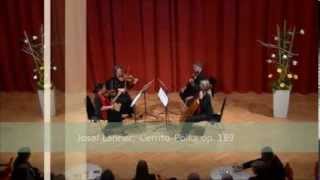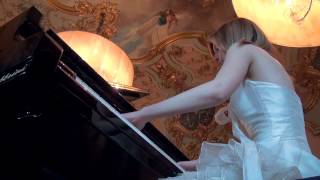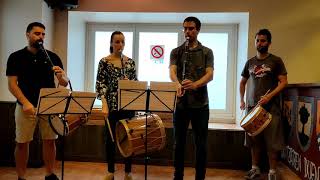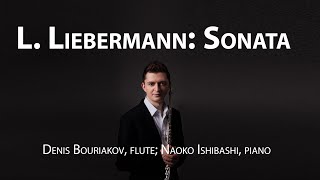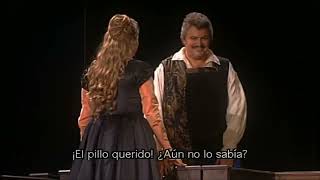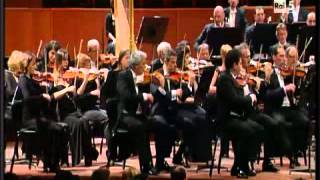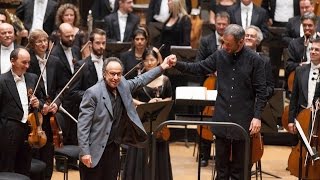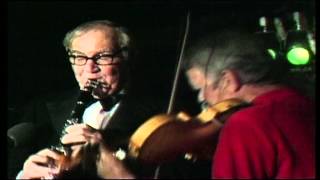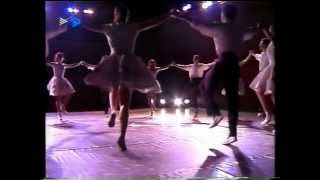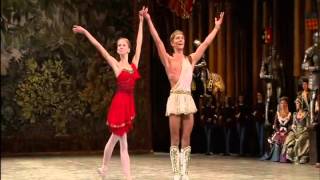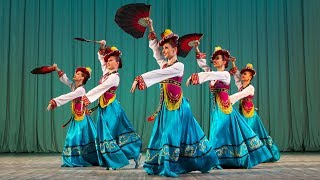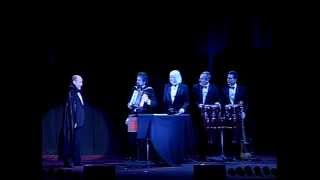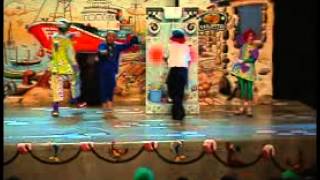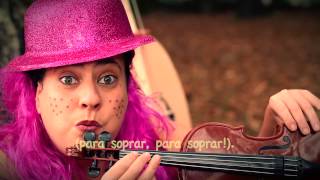September 11th celebration of the Diada (Catalonia Day)
Recommended music videos for initiation to classical music
Enric Morera i Viura (1865 - 1942) was a Catalan composer and musician. He wrote operas, stage music, symphonic works, choral works, concerts and a Requiem Mass ; but he is best known for his choral sardanas. His work is part of the neo-romantic aesthetic and is a magnificent example of Catalan musical nationalism . So much so that he wrote in Catalan (instead of Italian) everything concerning tempos, dynamics, agogics, etc. It is also worth noting the non-use of key signatures in his songs. All alterations are accidental, opting for this form of writing, like other composers of his time. Enric Morera 's personal collection is preserved in the Library of Catalonia .
L´Empordà is a sardana with music by Enric Morera and lyrics by Joan Maragall written in 1908 at the request of the Amics Tintorers choir of Barcelona as a present for the Erato Choral Society of Figueres . It is a sardana for male choir with an energetic rhythm, although it is frequently covered by a mixed choir as in the present case, sung by the Knox College Choir . It has been the official anthem of the Alt Empordà region since 2012.
Josef Lanner (1801-1843) was a composer of ballroom dance music, considered one of the composers most committed to renewing the waltz by taking it out of popular circles and bringing it into more sophisticated contexts. He competed with his friend Johan Strauss I by presenting his polkas and waltzes in Viennese high society.
Catalogue of LANNER's works . His works are classified by their Opus number (from the Latin opus 'work'; op. abbreviation) which is a term used in music to catalogue the works of most composers since the 17th century .
The Polka (or polka) is a popular dance that appeared in Bohemia (now the Czech Republic) around 1830, which began to become popular in Prague from 1835. Its music is written in 2/4 time and fast tempo; it is danced with lateral steps and rapid evolutions; it became very popular in Europe and America .
Today we attended the performance of Cerrito-Polka op. 189 written by Josef Lanner and performed by the Nexus Quartett Wien.
Franz Liszt (1811-1886) was a brilliant Hungarian pianist and successful composer whose works have survived through the ages; works for solo and concertante piano, as well as orchestral works among which his symphonic poems stand out, a musical form of which he was the progenitor. Liszt 's father, an amateur musician, gave him his first piano lesson at the age of seven. In October and November 1820, at the age of nine, he appeared in concerts in Sopron and Bratislava . His father arranged for Franz to be introduced to the Court of the House of Esterházy as a child prodigy. He was famous throughout Europe during the 19th century ; his contemporaries claimed him to be the most technically advanced pianist of his time and the greatest of all time.
The nocturne is a piece of vocal or instrumental music with a sweet melody and free structure. The name "nocturne" was first given in the 18th century to a piece played at evening parties. In its most common form (that is, as a single-movement piece generally written for a piano solo), the genre was cultivated mainly in the 19th century . The most famous exponent of this music was Frédéric Chopin , who wrote 21 works in that genre.
Liebesträume (Love Dream) is a set of three nocturnes written for piano by Franz Liszt , of which No. 3 , which we suggest today, is the best known; its interpretation is currently performed by the pianist Vanessa Benelli (1987).
The Txistu is a musical instrument that belongs to the European family of the “Three-hole flute”. It is played with one hand only (usually the left), so that the other is free to play the tambourine that hangs from the arm used to play the txistu. Currently tuned in F, it is frequently accompanied by the whistle or txistu haundi , a lower-pitched instrument, tuned in B flat . The txirula , a higher-pitched instrument, belongs to the same family, which is usually accompanied by the ttun ttun (string drum). The txistu is used in pilgrimages, parades, tributes, institutional events and in different types of concerts, both as a solo instrument accompanied by an orchestra, and forming a small txistu band , as is the case we are offering today; band made up of three voices (1st txistu, 2nd txistu and whistle) with accompaniment of the tambourine and the snare drum, drumstick or snare drum.
Today the Hego Haizeak Txistus Band made up of Aitor Urquiza (Txistu 1st), Ainara Martínez (Txistu 2nd), Xabier Olazabal (Silbote) and Beñat López (Atabal) offers us the Burundarrak suite articulated in three movements: I (0´5´´) Fandangoa .-. II (1´50´´) Arin-arin .-. III (3'47'') Biribilketa and written by Karlos Sánchez Ekiza .
Recommended classical music videos
Joseph Bodin de Boismortier (1689 – 1755) was a French Baroque composer who wrote both instrumental and vocal works, cantatas and ballets. Boismortier 's family moved from the composer's birthplace of Thionville in Lorraine to the city of Metz where he received his education. In 1713 he travelled to Perpignan , where he married Mara Valette ; in 1724 they moved to Paris where Boismortier began his prolific career as a composer. By 1747 he had published over 100 works for different combinations of voice and instruments. Boismortier was one of the first composers not to be dependent on a patron or protector, composing music of great beauty and sophistication that was greatly appreciated by the French public.
Catalogue of Boismortier's works . His works are classified by their Opus number (from the Latin opus 'work'; op. abbreviation) which is a term used in music to catalogue the works of most composers since the 17th century .
Today we offer the Sonata in E Minor op. 37, No. 2 for oboe, bassoon, and continuo written by Joseph Bodin de Boismortier and performed on this occasion by Meghan Woodard (oboe), Zachary Feingold (bassoon) and Irene Moretto (harpsichord); sonata articulated in three movements: I (0´6´´) ALLEGRO .-. II (2´36´´) ADAGIO .-. III (4´41´´) ALLEGRO
Richard Wagner (1813-1883) was a German composer, conductor, poet, essayist, playwright and musical theorist of the Romantic period ; a controversial figure for his anti-Semitic ideas and writings such as “ Judaism in Music ” in which he rails against the musical relationship of Jews with music. In his early days, his works followed the romantic tradition; but later he transformed musical thought with the idea of the “ total work of art ” (Gesamtkunstwerk). His capacity for philosophy, literature, music, performing arts, painting and sculpture is transferred to his operas conceived as an exponent of “ total art ”. With these principles he had the Bayreuther Festspielhaus theatre built so that he could stage his own operas for which he was not only the author of the music, but also the author of the libretto and the set design.
Die Meistersinger von Nürnberg (The Mastersingers of Nuremberg) is an opera in three acts with music and a German libretto by Richard Wagner . It is one of the longest operas, approximately around four and a half hours. It premiered at the Königliches Hof- und National-Theater in Munich , on 21 June 1868 under the baton of Hans von Bülow . The opera is a tribute to the bourgeoisie of medieval Germany and to Bach 's counterpoint.
The story takes place in Nuremberg in the mid -16th century . The plot revolves around the royal guild of Meistersinger (Mastersingers), an association of amateur poets and musicians, mostly from the middle class and often master craftsmen in their professions. The Meistersingers developed a craftsman's approach to music, with an intricate system of rules for the composition and performance of songs. The play draws much of its charm from its realistic depiction of the era and traditions of the Meistersinger guild. One of the main characters is the poet-shoemaker Hans Sachs (1494–1576), a genuine historical figure, the most famous of the historical Mastersingers.
Franz Welser-Möst (1960), the maestro who visits us today, is an Austrian conductor born in Linz , Austria , who studied violin during his youth and showed quite an interest in conducting. After being injured in a car accident, he gave up his violin studies and devoted himself entirely to conducting studies. His debut took place at the Salzburg Festival in 1985. Since then he has held relevant positions such as: principal conductor of the London Philharmonic Orchestra , general director of the Zurich Opera , music director (Generalmusikdirektor) of the Vienna State Opera ... In 2011 and 2013 he conducted the Vienna Philharmonic at the New Year's Concert (Neujahrskonzert) and is currently the music director of the Cleveland Orchestra .
Sergei Prokofiev (1891-1953) was a Soviet composer, pianist and conductor. As the creator of acknowledged masterpieces in numerous musical genres, he is considered one of the major composers of the 20th century . His works include such widely heard pieces as The Love for Three Oranges March, the Lieutenant Kikhe suite , the ballet Romeo and Juliet , from which The Dance of the Knights is taken, and Peter and the Wolf ... He created seven complete operas, seven symphonies, eight ballets, five piano concertos, two violin concertos, one cello concerto and nine completed piano sonatas. After his death in 1953, Arthur Honegger proclaimed that Prokofiev "would remain for us the greatest figure in contemporary music."
Romeo and Juliet is a ballet in three acts divided into thirteen scenes, including a prologue and an epilogue. It is one of the composer's most appreciated works, based on the high melodic inspiration, the great rhythmic variety and the memorable character of the main themes. The difficulty of the score prevented the composer from enjoying the success that his piece would have years later; he was criticized for the lack of lyricism and symphonic nature, as happened to Tchaikovsky .
Today we can watch the ballet suite conducted by Xian Zhang (1973), a Chinese-American conductor and the first woman to be chief conductor of the BBC Symphony Orchestra in Wales .
Benet Casablancas (Sabadell, 1956) is a Catalan composer, teacher and musicologist who has been the academic director of the Conservatorio Superior de Música del Liceu (Barcelona) since 2002. His works, which have been the subject of numerous commissions and have received numerous national and international awards, are regularly performed on the main stages of Europe, Canada, the USA, Japan and Latin America by highly prestigious groups, soloists and conductors. Casablancas has been an advisor to various institutions and a patron of various foundations, publishing numerous articles on historical and analytical subjects, and is frequently called upon as a jury member in European music composition and performance competitions and as a guest professor at various international centres.
An interlude (from Latin inter ludĕre , to play in fits and starts) is a piece or musical passage played between two parts or sections of a work. During the 18th century , such passages were inserted between the verses of hymns or psalms; in the latter case, organists often improvised them. Some written examples of this type survive today. It may occasionally appear between scenes in an opera, as in the " Sea Interludes " of the 1945 opera Peter Grimes by British composer Benjamin Britten , although they may also be conceived as independent pieces, as in the present case.
Today we offer Three Interludes for Orchestra presented in the following order: I (0:26) PASTORALE .-. II (6:04) SCHERZO .-. III (10:30) MEMENTO E CORALE. The interpretation is in charge of the Galicia Symphony Orchestra conducted by the Russian maestro Dima Slobodeniouk .
Recommended music videos for all tastes
Lluis Llach (1948) is a Catalan singer-songwriter who, along with other colleagues, was a promoter of the Nova cançó catalana and the author of various protest songs during the Franco era. In 1969 he gave a solo recital at the Palau de la Música , demonstrating his popularity among people of all ages. In 1973 he performed at the Olympia in Paris to great acclaim from the public and critics; during this period he also performed in Switzerland, Germany and Mexico . In 1976, after Franco 's death, he gave three recitals at the Palau des Sports in Montjuïc. In 1979 he was the first non-operatic singer to perform at the Liceu in Barcelona and in 1985 he filled the Camp Nou with more than 100,000 spectators. In 2007 he decided to end his career with a concert in Verges (Girona).
L'estaca (in Spanish, « The stake ») is a song composed in 1968 by Lluís Llach . This song, which has been translated into many languages, has become so popular that in many places it is considered native (even the Polish trade union Solidaridad adopted this song as its anthem). It was composed during the dictatorship of the dictator Franco and is a call for unity of action to free ourselves from bonds, to achieve freedom. It has become a symbol of the fight for freedom. “Don't you see the stake where we are all tied? If we can't get rid of it, we will never be able to walk! ... If I pull hard here and you pull hard there, surely, tumba tumba tumba, we will be able to free ourselves.”
Benny Goodman (1909 –1986) was an American jazz clarinetist and bandleader. Known as the King of Swing , he is, along with Glenn Miller and Count Basie , the most popular representative of this jazz style and the initiator of the so-called swing era . His continued successes inspired Goodman to organize a permanent orchestra with which the most relevant performers of the time collaborated. Furthermore, various composers from the classical world composed works for him. Thus, Aaron Copland dedicated his Clarinet Concerto to him, Béla Bartók his Contrasts for violin, clarinet and piano , Paul Hindemith his Clarinet Concerto and Malcolm Arnold with the Clarinet Concerto No. 2 .
Swing music, also known as swing jazz or simply swing , is a style of jazz that originated in the United States towards the end of 1920. Swing uses a rhythm section consisting of piano, double bass and drums; brass instruments such as trumpets and trombones; woodwind instruments such as saxophones and clarinets; and very occasionally, string instruments such as violin or guitar; it is also preferably based on medium to fast tempos and generalizes melodic riffs (short repetitive phrases). The characteristic ensemble of the style was the Big Band , with the role of the soloist acquiring great importance.
Céline Dion (born 1968) is a Canadian singer born in Quebec . Before achieving worldwide success, she emerged as a teen star in her native country, releasing a series of French-language albums that brought her great popularity. In 1990 she released Unison, her first English-language production, which marked the beginning of her outstanding and successful career in the English-speaking market. Dion is the Canadian with the most records sold in the world. Her music has been influenced by genres as varied as rock, R&B, gospel and classical music , among others. She has won five Grammy Awards and is the only artist to have two consecutive albums with sales of more than 30 million copies. According to Sony Music Entertainment , the singer has sold more than 200 million musical productions worldwide.
Joaqui (Joaquinha Lerena De La Riva, Mar del Plata 1994) is an Argentine singer, songwriter and actress. During her childhood she moved with her mother to Tamarindo ( Costa Rica ) and in her adolescence she returned to her hometown in Argentina , where she lived with her maternal grandmother. Her interest in music began when she was 18, leading her to participate twice in the Red Bull Batalla de Gallos , one of the largest freestyle competitions in Latin America . She rose to fame for her songs "Butakera", "Tu amor" and "Dos besitos" which were placed within the first 15 positions on the Argentina Hot 100 list published by Billboard magazine. She is considered one of the female pioneers of freestyle and one of the greatest referents of RKT in Argentina .
Recommended peculiar videos
The Sardana is a traditional Catalan group dance performed in a circle. Participants hold hands in pairs, using an alternating pattern of woman-man-woman-man. The sardana is formally played by a cobla (a wind band with typical Catalan instruments and double bass); José María Ventura is responsible for the current formation of the cobla and the stabilisation of its rhythmic pattern. The style of circle dance can be found in numerous cultures around the world and the act of holding hands dates back, according to some authors, to Roman times. The composition of the cobla and the current choreography of the dance were established and unified in the 19th century . In 2010, the Generalitat of Catalonia declared it a heritage festive element of national interest .
La Santa Espina is a sardana written by Ángel Guimerá with music by Enric Morera . It premiered on 19 January 1907 at the Teatro Principal in Barcelona and its performance was banned during the dictatorship of Primo de Rivera , as well as in the first part of the Franco dictatorship because "certain elements have turned the sardana La Santa Espina into a representative hymn of hateful ideas and criminal aspirations, listening to its music with the respect and reverence that is paid to national anthems." Later, after the dictator's death, the piece was performed in January 1983 by the Royal Guard in a concert held at the El Pardo barracks.
Riccardo Drigo (1846-1930) was an Italian conductor and composer born in Padua . After achieving some notoriety as both a conductor and a composer, he moved to Saint Petersburg where he conducted several operas and ballets. He remained in Russia for 40 years writing several operas and ballets in collaboration with notable choreographers such as Marius Petipa , Lev Ivanov and Michel Fokine with whom he would collaborate closely.
Pas de deux (in Spanish, Step for two ) . In ballet, a Pas de deux, also known as Grand pas de deux , is one performed jointly by two people. It usually consists of an entrée (entrance of the couple), adagio, two variations (one for each dancer, usually an allegro) and a coda . Heir to the ballet entrée , the pas de deux appears in the mid -18th century during action ballet and will be fully developed in the 19th century , in Romantic ballet. It symbolizes the love of a couple and illustrates the most poetic moments of ballet. Contemporary choreographers prefer to speak of "duo" rather than pas de deux .
The Pas de Deux from Diana and Actaeon , which we are offering today, is one of the most performed Pas-de-deux in the last years of the 20th century , although its creation dates back many decades. As it is aimed at the technical virtuosity of its two performers, and this being one of the greatest attractions of our time, many of today's stars have contributed to popularizing it.
Today we are treated to the work of Anastasia Stashkevich (1984) and Vyacheslav Lopatin (1984), principal dancers of the Bolshoi Ballet .
Dance in Korea . The beginnings of dance in Korea are believed to date back at least 5,000 years and to have originated in ancient shamanic rituals. The first traces of Korean dance can be seen during the Three Kingdoms period. During the time of the later Korean kingdoms, dance benefited from regular support from the royal court, numerous academies were established, and there was even an official government ministry dedicated to dance. Today, there is a wide variety of dance in Korea , ranging from courtly and folk dance to newly created contemporary dance.
The Igor Moiseyev Ballet, born in the heart of the Bolshoi Theatre in Moscow, is one of the world's great ballet companies that manages to synthesize the spontaneity of popular dances with the academicism of classical ballet, and which today stages the Sancheonga popular dance with its usual choreographic rigor and respect for the roots and habits of Korean folklore.
Les Luthiers is an Argentine musical-humorous group, very popular in their country and in other Spanish-speaking countries. The group uses music as a fundamental element of their performances, frequently incorporating informal instruments created from everyday materials. From this characteristic comes their name, luthier , a word from the French language that designates the creator, adjuster and person in charge of the repair of string musical instruments. They have been recognized with illustrious distinctions both in their native Argentina , as well as in Spain and the USA .
Recommended music videos for children
Various Wikipedia articles have been used to write these texts.
The texts of Videomusicalis are written in Basque, Spanish and English.






